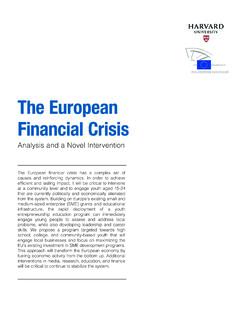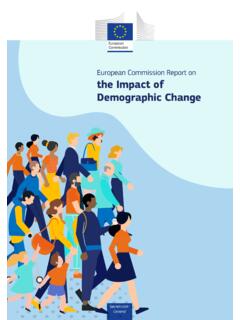Transcription of European Green Deal Communication - European Commission
1 EN EN European Commission Brussels, COM(2019) 640 final Communication FROM THE Commission TO THE European PARLIAMENT, THE European COUNCIL, THE COUNCIL, THE European economic AND SOCIAL COMMITTEE AND THE COMMITTEE OF THE REGIONS The European Green deal 2 1. INTRODUCTION - TURNING AN URGENT CHALLENGE INTO A UNIQUE OPPORTUNITY This Communication sets out a European Green deal for the European Union (EU) and its citizens. It resets the Commission s commitment to tackling climate and environmental-related challenges that is this generation s defining task. The atmosphere is warming and the climate is changing with each passing year. One million of the eight million species on the planet are at risk of being lost. Forests and oceans are being polluted and destroyed1.
2 The European Green deal is a response to these challenges. It is a new growth strategy that aims to transform the EU into a fair and prosperous society, with a modern, resource-efficient and competitive economy where there are no net emissions of greenhouse gases in 2050 and where economic growth is decoupled from resource use. It also aims to protect, conserve and enhance the EU's natural capital, and protect the health and well-being of citizens from environment-related risks and impacts. At the same time, this transition must be just and inclusive. It must put people first, and pay attention to the regions, industries and workers who will face the greatest challenges. Since it will bring substantial change, active public participation and confidence in the transition is paramount if policies are to work and be accepted.
3 A new pact is needed to bring together citizens in all their diversity, with national, regional, local authorities, civil society and industry working closely with the EU s institutions and consultative bodies. The EU has the collective ability to transform its economy and society to put it on a more sustainable path. It can build on its strengths as a global leader on climate and environmental measures, consumer protection, and workers rights. Delivering additional reductions in emissions is a challenge. It will require massive public investment and increased efforts to direct private capital towards climate and environmental action, while avoiding lock-in into unsustainable practices. The EU must be at the forefront of coordinating international efforts towards building a coherent financial system that supports sustainable solutions.
4 This upfront investment is also an opportunity to put Europe firmly on a new path of sustainable and inclusive growth. The European Green deal will accelerate and underpin the transition needed in all sectors. The environmental ambition of the Green deal will not be achieved by Europe acting alone. The drivers of climate change and biodiversity loss are global and are not limited by national borders. The EU can use its influence, expertise and financial resources to mobilise its neighbours and partners to join it on a sustainable path. The EU will continue to lead international efforts and wants to build alliances with the like-minded. It also recognises the need to maintain its security of supply and competitiveness even when others are unwilling to act.
5 This Communication presents an initial roadmap of the key policies and measures needed to achieve the European Green deal . It will be updated as needs evolve and the 1 Sources: (i) Intergovernmental Panel on Climate Change (IPCC): Special Report on the impacts of global warming of C; (ii) Intergovernmental Science-Policy Platform on Biodiversity and Ecosystem Services: 2019 Global assessment report on biodiversity and ecosystem services; (iii) The International Resource Panel: Global Resources Outlook 2019: Natural Resources for the Future We Want; (iv) European Environment Agency: the European environment state and outlook 2020: knowledge for transition to a sustainable Europe 3 policy responses are formulated.
6 All EU actions and policies will have to contribute to the European Green deal objectives. The challenges are complex and interlinked. The policy response must be bold and comprehensive and seek to maximise benefits for health, quality of life, resilience and competitiveness. It will require intense coordination to exploit the available synergies across all policy areas2. The Green deal is an integral part of this Commission s strategy to implement the United Nation s 2030 Agenda and the sustainable development goals3, and the other priorities announced in President von der Leyen s political guidelines4. As part of the Green deal , the Commission will refocus the European Semester process of macroeconomic coordination to integrate the United Nations sustainable development goals, to put sustainability and the well-being of citizens at the centre of economic policy, and the sustainable development goals at the heart of the EU s policymaking and action.
7 The figure below illustrates the various elements of the Green deal . Figure 1: The European Green deal 2 In line with the findings of the 2020 European environment state and outlook 2020: knowledge for transition to a sustainable Europe ( European Environment Agency) 3 4 See Political Guidelines of President elect Ursula von der Leyen: Political guidelines for the next Commission (2019-2024) A Union that strives for more: My agenda for Europe : 4 2. TRANSFORMING THE EU S ECONOMY FOR A SUSTAINABLE FUTURE Designing a set of deeply transformative policies To deliver the European Green deal , there is a need to rethink policies for clean energy supply across the economy, industry, production and consumption, large-scale infrastructure, transport, food and agriculture, construction, taxation and social benefits.
8 To achieve these aims, it is essential to increase the value given to protecting and restoring natural ecosystems, to the sustainable use of resources and to improving human health. This is where transformational change is most needed and potentially most beneficial for the EU economy, society and natural environment. The EU should also promote and invest in the necessary digital transformation and tools as these are essential enablers of the changes. While all of these areas for action are strongly interlinked and mutually reinforcing, careful attention will have to be paid when there are potential trade-offs between economic , environmental and social objectives. The Green deal will make consistent use of all policy levers: regulation and standardisation, investment and innovation, national reforms, dialogue with social partners and international cooperation.
9 The European Pillar of Social Rights will guide action in ensuring that no one is left behind. New measures on their own will not be enough to achieve the European Green deal s objectives. In addition to launching new initiatives, the Commission will work with the Member States to step up the EU s efforts to ensure that current legislation and policies relevant to the Green deal are enforced and effectively implemented. Increasing the EU s climate ambition for 2030 and 2050 The Commission has already set out a clear vision of how to achieve climate neutrality by 20505. This vision should form the basis for the long-term strategy that the EU will submit to the United Nations Framework Convention on Climate Change in early 2020. To set out clearly the conditions for an effective and fair transition, to provide predictability for investors, and to ensure that the transition is irreversible, the Commission will propose the first European Climate Law by March 2020.
10 This will enshrine the 2050 climate neutrality objective in legislation. The Climate Law will also ensure that all EU policies contribute to the climate neutrality objective and that all sectors play their part. The EU has already started to modernise and transform the economy with the aim of climate neutrality. Between 1990 and 2018, it reduced greenhouse gas emissions by 23%, while the economy grew by 61%. However, current policies will only reduce greenhouse gas emissions by 60% by 2050. Much remains to be done, starting with more ambitious climate action in the coming decade. By summer 2020, the Commission will present an impact assessed plan to increase the EU s greenhouse gas emission reductions target for 2030 to at least 50% and towards 55% compared with 1990 levels in a responsible way.
















